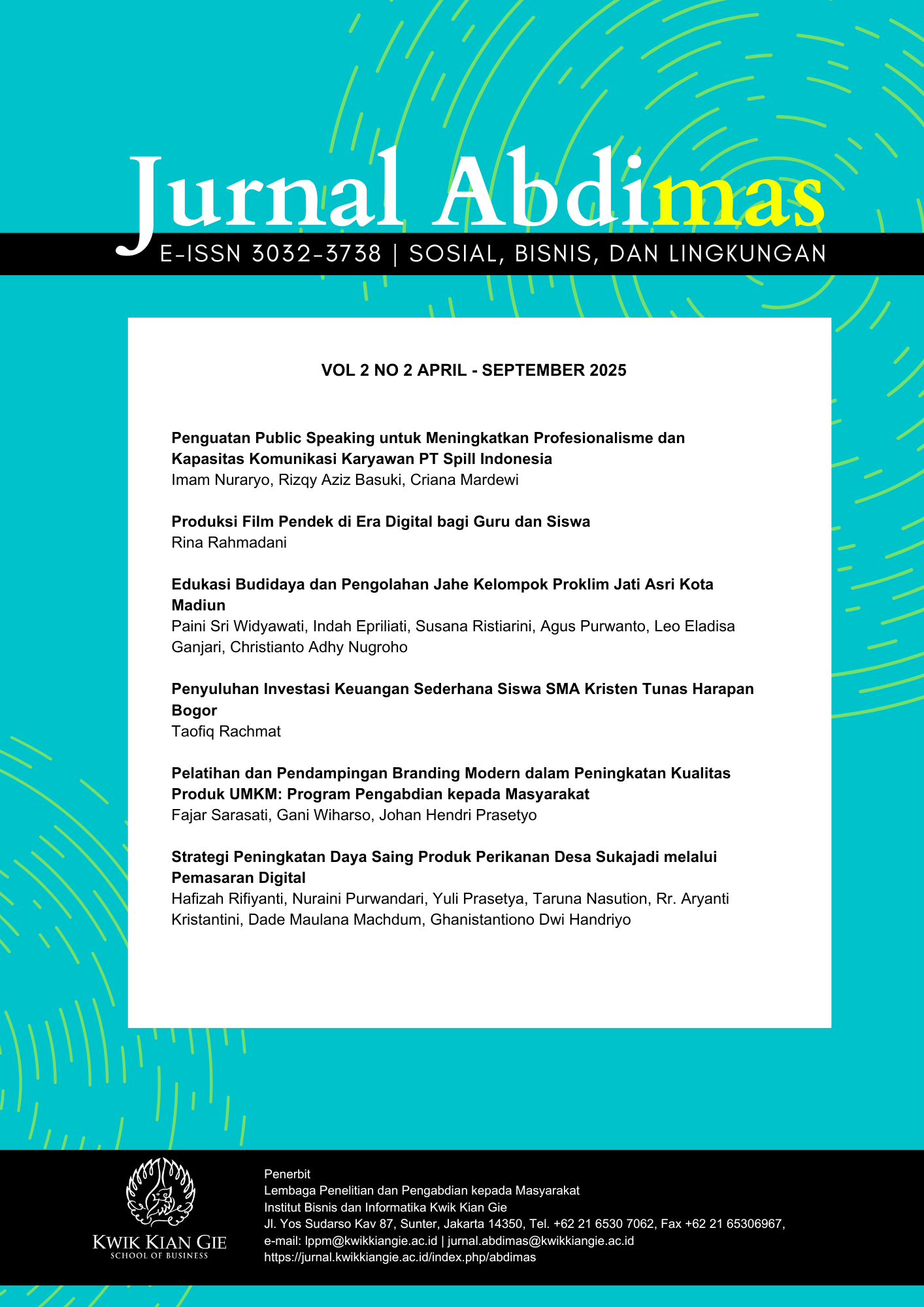Edukasi Budidaya dan Pengolahan Jahe Kelompok Proklim Jati Asri Kota Madiun
Main Article Content
Abstract
Ginger is spice plant that potential to develop to be phytopharmacon because it contains bioactive compounds, such as alkaloid, flavonoid, phenolic, triterpenoid, saponin, and essential oil, i.e., gingerol, shogaol, zingiberene, (+)-curcumene, (-)-β-sesquiphelandrene paradol, and bisabolene. These compounds can used to maintain body health. Proklim Jati Asri oversees the PKK Asman Toga, a community group enthusiastic about growing ginger to preserve the environment and reduce the greenhouse effect. The Proklim program, in partnership with the Faculty of Agricultural Technology, Widya Mandala Catholic University, Surabaya, aims to provide ginger cultivation and processing training to community groups with limited knowledge and skills. This training allows them to cultivate and process ginger into semi-finished and finished products that can generate income, contribute to environmental conservation, and create herbal medicine at home. This activity was held on Tuesday, June 17, 2025, and was attended by 22 participants (women from the PKK Asman Toga). The knowledge evaluation showed a 68,18% of participant increased in theirs’s knowledge. Throughout the activity, participants were highly enthusiastic, collaborated with each other to complete tasks, and actively participated in the training. The community service activity succeeded in improving the participants' abilities in cultivating and processing ginger.
Downloads
Article Details

This work is licensed under a Creative Commons Attribution-NonCommercial-ShareAlike 4.0 International License.
References
Ahnafani, M.N., et al. (2024). Jahe (Zingiber officinale): Tinjauan Fitokimia, Farmakologi, dan Toksikologi. Jurnal Ilmu Kedokteran dan Kesehatan, 11(10), 1992-1998. https://doi.org/10.33024/jikk.v11i10.15945
Farrel, R., Aulawi, T., & Darmawi, A. (2020). Analisis Mutu Simplisia Rimpang Jahe Merah (Zingiber officinale Var. Rubrum) dengan Suhu Pengeringan yang Berbeda. Jurnal Pertanian Tropik, 7(1),136-143. https://doi.org/10.32734/jopt.v7i1.3866
Hertiana, T. (2021). Mengenal Pengolahan Jahe: Beda Cara Beda Kandungan Kimia, Beda Manfaat?. Obat Alami untuk Indonesia. https://kanalpengetahuan.farmasi.ugm.ac.id/2021/02/26/mengenal-pengolahan-jahe-beda-cara-beda-kandungan-kimia-beda-manfaat/
Kementerian Lingkungan Hidup [ KLH]. 2025. Program Kampung Iklim (Proklim). Jl. DI Panjaitan Kav.24, Kebon Nanas, Jakarta Timur.https://kemenlh.go.id/contents/16/Program-Kampung-Iklim-Proklim#:~:text=Apa%20Itu%20Program%20Kampung%20Iklim,swasta%2C%20dan%20lembaga%20swadaya%20masyarakat.
Lestari, F.P., et al. 2025. Pemberdayaan Masyarakat Melalui Pelatihan Budidaya dan Diversifikasi Produk Olahan Jahe Di Kelurahan Karangmalang. Jurnal Pedamas (Pengabdian Kepada Masyarakat), 3(4),1310-1316. https://pekatpkm.my.id/index.php/JP/article/view/731
Magdalena, I., et al. (2021). Analisis Penggunaan Teknik Pre-Test dan Post-Test Pada Mata Pelajaran Matematika Dalam Keberhasilan Evaluasi Pembelajaran Di SDN Bojong 04. Nusantara : Jurnal Pendidikan dan Ilmu Sosial, 3(2), 150-165. https://doi.org/10.36088/nusantara.v3i2.1250
Mazzlin, N.E., Widayanti, S., & Nugroho, S.D. (2022). Analisis Posisi Komoditas Jahe Indonesia Di Pasar Internasional. Jurnal Ilmiah Membangun Desa dan Pertanian, 7(6), 226-235. https://doi.org/10.37149/JIMDP.v7i6.89
Mustarin, AS., et al. (2021). Pengolahan Serbuk Instant Jahe Merah. Seminar Nasional Hasil Pengabdian 2021 Universitas Negeri Makasar. Penguatan Riset, Inovasi, dan Kreativitas Peneliti di Era Pandemi Covid-19, 11, 1258-1263. https://ojs.unm.ac.id/semnaslpm/article/view/26331
Nugroho, P., Muhammad, F., & Alla, A. (2017). Pengaruh Standar Keamanan Pangan Terhadap Ekspor Produk Biofarmaka Indonesia. Jurnal Ekonomi dan Kebijakan Pembangunan, 6(1), 41–57. https://doi.org/https://doi.org/10.29244/jekp.6.1.2017.41-57
Sari, D., & Nasuha, A. (2021). Kandungan Zat Gizi, Fitokimia, dan Aktivitas Farmakologis pada Jahe (Zingiber officinale Rosc.): Review. Tropical Bioscience: Journal of Biological Science, 1(2), 11-18. https://jurnal.uinbanten.ac.id/index.php/tropicalbiosci/article/download/5246/3339/15851
Siregar, P.N.B., et al. (2022). Review: Kandungan Kimia Jahe Merah (Zingiber officinale var. Rubrum) dan Pembuktian In Silico sebagai Inhibitor SARS-CoV-2. Jurnal Pharmascience, 9(2), 185-200. https://dx.doi.org/10.20527/jps.v9i2.13149
Sugiarti, L., & Setyawati, T. (2017). Karakteristik Mutu Simplisia Rimpang Jahe di PJ. Cap Klaceng Kudus. Cendekia Utama Jurnal Keperawatan dan Kesehatan Masyarakat, 2(5),43-52. https://doi.org/10.31596/jcu.v2i5.163
Suhartini, N. A., Widi, R. H., & Darusman, D. (2021). Daya Saing Pala, Lawang, dan Kapulaga Indonesia di Pasar Internasional. Jurnal Agristan, 3(2), 84–110. https://doi.org/https://doi.org/10.37058/agristan.v3i2.3685
Triyani, Y., et al. (2024). Peran Perempuan dan Kolaborasi Lintas Generasiuntuk Keluarga Berdaya Indonesia Maju. Jurnal Abdimas, 2(1), 1-11. https://doi.org/10.46806/abdimas.v2i1.1264
Yuliani, S., & Kailaku, S.I. (2009). Pengembangan Produk Jahe Kering Dalam Berbagai Jenis Industri. Buletin Teknologi Pascapanen Pertanian, 5, 61-68. https://repository.pertanian.go.id/server/api/core/bitstreams/de5a3f8a-fd2b-40a5-a029-67f95db6892c/content
